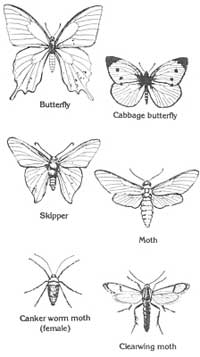Lepidoptera: Moths, Butterflies, and Skippers
(from the Greek: lepidos = scale + ptera = wings)
Lepidoptera are easy to recognize. They have coiled sucking mouthparts, scales on their wings, and complete metamorphosis. The main difference between moths, butterflies, and skippers is in the antennae. Butterflies have thread-like antennae that are thickened or knobbed at the end. Skippers have thread-like, knobbed antennae as well, but the knobs are tipped with distinct hooks. Moth antennae may be thread-like, feathery or spindle shaped, but never have knobs. Most moths fly at night, while butterflies and skippers tend to be day fliers. Most moth caterpillars spin a cocoon in which to pupate, but butterflies never spin a cocoon. A few moths are wingless. Caterpillars of many moths (and a few butterflies and skippers) are important pests of plants. Most caterpillars eat plant leaves, but the caterpillars of some moths eat woolen materials and stored food. Some bore into plants. A few kinds of caterpillars are adapted for living in water. Some caterpillars have poisonous spines on their body, and if they are handled carelessly can produce a sting as bad as a wasp sting.

